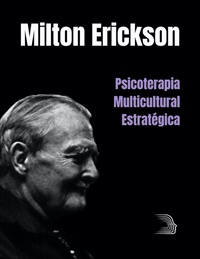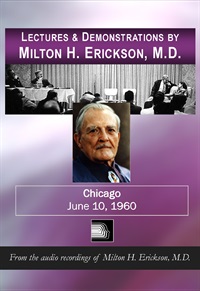
- Average Rating:
- Not yet rated
- Topic Areas:
- Hypnosis | Ericksonian Hypnosis and Therapy Techniques | Milton Erickson | Binds | Resistance
- Categories:
- Erickson Materials | Lectures & Demonstrations | Milton H. Erickson Collections
- Faculty:
- Milton H. Erickson, MD
- Duration:
- 3:57:01
- Format:
- Audio Only
- Original Program Date:
- Jun 10, 1960
- Short Description:
- During this seminar, Dr. Erickson describes essential skills for working with resistant patients, the use of permissive language, ordeal therapy, geometric progression, and therapeutic double binds. Erickson conducts a demonstration, answers questions from the audience, and elaborates on his thinking with case illustrations that include: sexual dysfunction, stuttering, bed wetting, childhood eating disorders, compulsive habits, phobias and self-defeating behavior.
- Price:
- $40.00 - Base Price
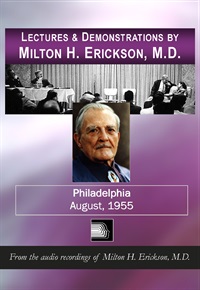
- Average Rating:
- Not yet rated
- Topic Areas:
- Hypnosis | Milton Erickson | Dissociation | Unconscious Processes | Ericksonian Hypnosis and Therapy Techniques
- Categories:
- Erickson Materials | Lectures & Demonstrations | Milton H. Erickson Collections
- Faculty:
- Milton H. Erickson, MD
- Duration:
- 2:17:27
- Format:
- Audio Only
- Original Program Date:
- Aug 01, 1955
- Short Description:
- In this set, Erickson communicates the timeless principles of hypnosis that he observed, discovered and utilized. He emphasizes the paramount importance of protecting the patient and establishing trust as the very foundation of the cooperative relationship characteristic of hypnosis. He stresses the importance of understanding the meaningful need of the patient and reviews, with many examples, the techniques of rehearsal, uncovering, dissociation, regression, time-distortion, revivification, visualization, orientation to the past and to the future, trusting the unconscious mind, and post-hypnotic suggestion.
- Price:
- $20.00 - Base Price
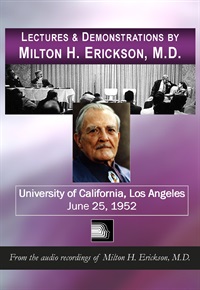
- Average Rating:
- Not yet rated
- Topic Areas:
- Hypnosis | Milton Erickson | Ericksonian Hypnosis and Therapy Techniques | Hypnotic Phenomena
- Categories:
- Erickson Materials | Lectures & Demonstrations | Milton H. Erickson Collections
- Faculty:
- Milton H. Erickson, MD
- Duration:
- 5:32:57
- Format:
- Audio Only
- Original Program Date:
- Jun 25, 1952
- Short Description:
- Five hours of instruction by Dr. Erickson on two general topics: Control of Psychological Functions by Hypnosis and Hypnotic Approaches to Therapy.
- Price:
- $62.00 - Base Price
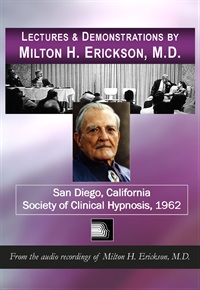
Lectures & Demonstrations of Milton H. Erickson, MD – San Diego - Society of Clinical Hypnosis, 1962
- Average Rating:
- Not yet rated
- Topic Areas:
- Hypnosis | Milton Erickson | Ericksonian Hypnosis and Therapy Techniques | Family Therapy | Pain and Healing | Sex and Sexuality
- Categories:
- Erickson Materials | Lectures & Demonstrations | Milton H. Erickson Collections
- Faculty:
- Milton H. Erickson, MD
- Duration:
- 5:29:03
- Format:
- Audio Only
- Original Program Date:
- Apr 29, 1962
- Short Description:
- Audio recording of Dr. Erickson describing essential differences between traditional hypnosis and modern hypnosis.
- Price:
- $50.00 - Base Price
- Average Rating:
- Not yet rated
- Topic Areas:
- Milton Erickson | Ericksonian Hypnosis and Therapy Techniques | Hypnotherapy | Phobia | Strategic Therapy | Hypnosis
- Bundle:
- Spanish Erickson Video Bundle
- Categories:
- Erickson Streaming Video Collection | Erickson Materials | Milton H. Erickson Collections | Spanish | World Languages
- Faculty:
- Jeffrey Zeig, PhD | Milton H. Erickson, MD
- Course Levels:
- Master Degree or Higher in Health-Related Field
- Duration:
- 1 Hour 12 Minutes
- Format:
- Audio and Video
- Original Program Date:
- Aug 13, 2020
- Short Description:
- Este video contiene la mejor ilustración de cómo Milton Erickson maneja los casos que se le presentan. Utilizando tanto la hipnoterapia como las directivas estratégicas, Erickson trabaja con una mujer que tiene fobia a volar en un avión. Este caso significativo ejemplifica los principios y prácticas fundamentales de un enfoque ericksoniano. Estos pueden aplicarse a otros problemas que se presenten y ser utilizados por los médicos que se suscriben a otras metodologías de tratamiento para un problema en particular.
- Price:
- $49.95 - Base Price
- Average Rating:
- Not yet rated
- Topic Areas:
- Milton Erickson | Multicultural | Ericksonian Hypnosis and Therapy Techniques | Utilization | Hypnosis | Psychotherapy | Strategic Therapy
- Bundle:
- Spanish Erickson Video Bundle
- Categories:
- Erickson Streaming Video Collection | Erickson Materials | Milton H. Erickson Collections | Spanish | World Languages
- Faculty:
- Jeffrey Zeig, PhD | Milton H. Erickson, MD
- Course Levels:
- Master Degree or Higher in Health-Related Field
- Duration:
- 59 Minutes
- Format:
- Audio and Video
- Original Program Date:
- Aug 13, 2020
- Short Description:
- Milton Erickson a menudo aconsejaba a los estudiantes de psicoterapia que estudiaran antropología para que la terapia pudiera proporcionarse desde la perspectiva del trasfondo cultural del cliente. En el video, Erickson usa su comprensión de la orientación cultural cuando trabaja con un adolescente donde el problema que se presenta es un defecto del habla. Este es un caso muy informativo del uso de procesos estratégicos y sistémicos que se pueden aplicar a otros problemas presentes.
- Price:
- $19.95 - Base Price
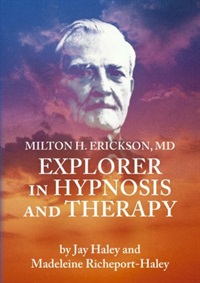
Milton H. Erickson, MD: Explorer in Hypnosis and Therapy - by Jay Haley and Madeline Richeport-Haley
- Average Rating:
- Not yet rated
- Topic Areas:
- Milton Erickson | Hypnosis
- Categories:
- Jay Haley | Erickson Materials | Milton H. Erickson Collections | Biographical Video
- Faculty:
- Milton H. Erickson, MD | Jay Haley, MA
- Duration:
- 1 hour
- Format:
- Audio and Video
- Original Program Date:
- Dec 31, 2005
- Short Description:
- Narrated by Jay Haley, this full color, 60-minute documentary, now available in On Demand and DVD format, offers an intimate and far-reaching portrait of this remarkable individual's life and work. You will learn how Milton Erickson overcame numerous adversities in his early life dyslexia, complete paralysis from polio at age 17, and chronic pain and how these events formed the genesis of his development as an innovator in hypnosis and therapy. Featuring abundant footage of Erickson during interviews and therapeutic sessions, many of which have never been previously released, you will learn more about the man and his work through fascinating interviews with his colleagues, students, patients, and family members. This inspiring portrait of one of the most important therapists of our time will enrich the lives of anyone interested in the extraordinary potential of the human spirit.
- Price:
- $29.95 - Base Price
Tags: Milton Erickson Hypnosis
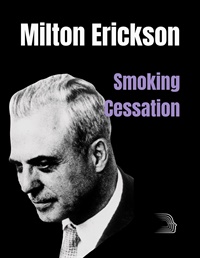
- Average Rating:
- Not yet rated
- Topic Areas:
- Ericksonian Hypnosis and Therapy Techniques | Milton Erickson | Addiction | Habits | Tailoring | Hypnosis
- Categories:
- Erickson Streaming Video Collection | Erickson Materials | Milton H. Erickson Collections
- Faculty:
- Jeffrey Zeig, PhD | Milton H. Erickson, MD
- Course Levels:
- Master Degree or Higher in Health-Related Field
- Duration:
- 1h 14m
- Format:
- Audio and Video
- Original Program Date:
- May 07, 2021
- Short Description:
- A client asks Erickson to help him stop smoking tobacco. Rather than using a formula, Erickson tailors a treatment approach to both address underlying problems and elicit resources.
- Price:
- $39.95 - Base Price
- Average Rating:
- Not yet rated
- Topic Areas:
- Milton Erickson | Ericksonian Hypnosis and Therapy Techniques | Hypnosis | Destabilization | Dissociation | Seeding
- Bundle:
- Spanish Erickson Video Bundle
- Categories:
- Erickson Materials | Erickson Streaming Video Collection | Milton H. Erickson Collections | Spanish | World Languages
- Faculty:
- Milton H. Erickson, MD | Jeffrey Zeig, PhD
- Course Levels:
- Master Degree or Higher in Health-Related Field
- Duration:
- 1 Hour 11 Minutes
- Format:
- Audio and Video
- Original Program Date:
- May 07, 2020
- Short Description:
- En la primera parte de Sembrando un tema - Un seminario de enseñanza con Milton Erickson, serás testigo de cómo Erickson planta una semilla sin problemas, conecta los puntos, desarrolla un tema y cierra el ciclo en un período de clase. Aprenderá cómo Erickson condujo la disociación a través del tempo, el contenido y el tono de sus palabras.
- Price:
- $29.95 - Base Price
- Average Rating:
- Not yet rated
- Topic Areas:
- Milton Erickson | Arm Levitation | Ericksonian Hypnosis and Therapy Techniques | Hypnosis | Trance | Utilization | Hypnotic Phenomena
- Bundle:
- Spanish Erickson Video Bundle
- Categories:
- Erickson Materials | Erickson Streaming Video Collection | Milton H. Erickson Collections | Spanish | World Languages
- Faculty:
- Milton H. Erickson, MD | Jeffrey Zeig, PhD
- Course Levels:
- Master Degree or Higher in Health-Related Field
- Duration:
- 1 Hour 19 Minutes
- Format:
- Audio and Video
- Original Program Date:
- May 07, 2020
- Short Description:
- En la segunda parte de un seminario de enseñanza con Milton Erickson, será testigo de cómo Erickson observó y utilizó cuidadosamente los comportamientos no verbales de un estudiante para desarrollar una experiencia de trance utilizando la levitación del brazo mientras interactúa simultáneamente para enseñar a otros estudiantes. Verá cómo el Dr. Erickson utilizó estratégicamente los fenómenos hipnóticos.
- Price:
- $29.95 - Base Price
Please wait ...



